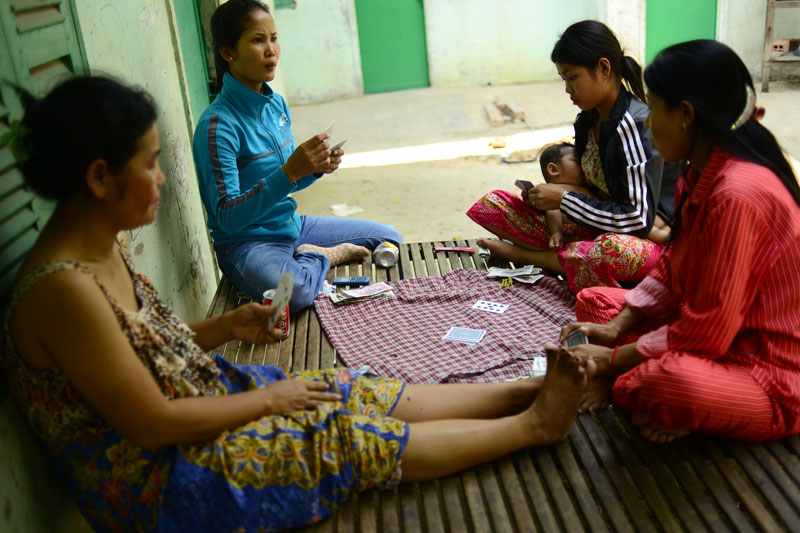Most garment factories did not open for business Thursday, choosing to extend the Khmer New Year holidays—which officially ended Wednesday—rather than face industrial action in the form of a planned nationwide stay-at-home strike.
However, a number of workers interviewed Thursday said they knew nothing about the strike, called by eight unions to demand a higher minimum wage and the release of 21 unionists and factory workers arrested during the last round of strikes in December.

Motivated by the fear of violence, the need to earn every dollar they can, or simple indifference, they said they would be back at their workstations as soon as the factory doors opened in the next few days.
Touch, who gave only her first name, was playing a game of cards with fellow garment workers in her dormitory along factory-lined Veng Sreng Street. The unions behind the strike are asking workers to stay home until Wednesday. But Touch said she had not even heard of the strike and would be back at work on Monday, as soon as her factory reopened.
“I don’t know about the unions,” she said. “We have to go to work on the 21st. If we do not go to work we can’t make money.”
Besides, she said, “We can’t beat them because they are the owners. And we’re afraid of the killings. It’s still in our minds.”
Touch was referring to five garment workers whom military police shot dead during a protest for higher wages on Veng Sreng Street on January 3, the day the last round of garment strikes came to an abrupt and bloody end. More than 40 garment workers were also injured in the indiscriminate shootings.
In the midst of those strikes, which had started the month before, the Labor Ministry raised the minimum wage for garment workers from $95 a month to $100. For Touch and her friends, the costs of the strikes decidedly outweighed the benefits.
“It was only $5, and do you know how many people were killed?” she said.
Pouch Polin, who works at another factory on Veng Sreng Street, said she would be back at her station today. She also said she had not heard of the strike. Ms. Polin said she liked the idea of a $160 minimum wage but did not want to see a repeat of January’s violence.
“I’m afraid of the crackdown, and we are all women,” she said.
Ken Loo, secretary-general of the Garment Manufacturers Association in Cambodia (GMAC), which represents most of the 500-plus exporting garment factories in the country, said most had decided to stay closed Thursday after making arrangements with their workers, for example, by swapping vacation days.
“It’s safe to say a majority are not open today,” he said. “It’s nothing new…. The factories planned for this.”
GMAC says the last round of strikes cost manufacturers $42.2 million in lost production and millions more in property damage. Whether they get hit in the pocket this time, Mr. Loo said, will only become apparent once the factories start coming back online in the next few days.
“To see if it’s really a strike, we have to wait until Monday,” he said.
GMAC is arguing that the planned work stoppage does not fit the definition of a strike under Cambodia’s Labor Law, because the workers will be withholding their labor outside of the factories themselves.
In any case, the unions say they are winning already.
Sieng Sambath, who heads the Worker Friendship Union Federation, said that by pressuring factories to extend the Khmer New Year holiday, unions have also forced them to push back production and postpone delivery on orders. And while the days may later be deducted from the workers’ annual leave, he said factories rarely grant those days in full, even when workers take the proper steps to request them.
“It’s a success for our unions because we were able to demand that the factories allow the workers to take more days off,” he said.
Pav Sina, president of the Collective Union of Movement of Workers, agreed.
“When the factories can’t produce on time, they will lose orders and lose revenue,” he said.
Mr. Sina said he expected up to 200,000 workers—about a third of the country’s total garment sector workforce—to join the stay-at-home strike by April 22.
David Welsh, country program director for Solidarity Center, a U.S.-based labor rights group, agreed with Mr. Loo that the strike’s impact will not be clear until next week.
But whatever the coming cost of the strike, Mr. Welsh said the factories could have avoided it by making a concerted effort to settle the wage dispute.
“The impact on the factories won’t be close to the impact the workers have faced by not having a livable wage,” he said.




